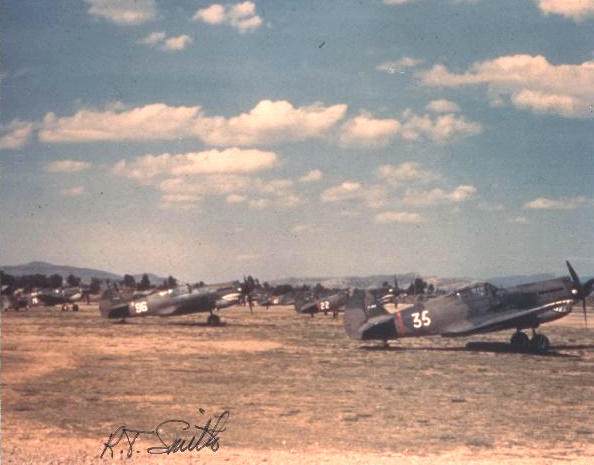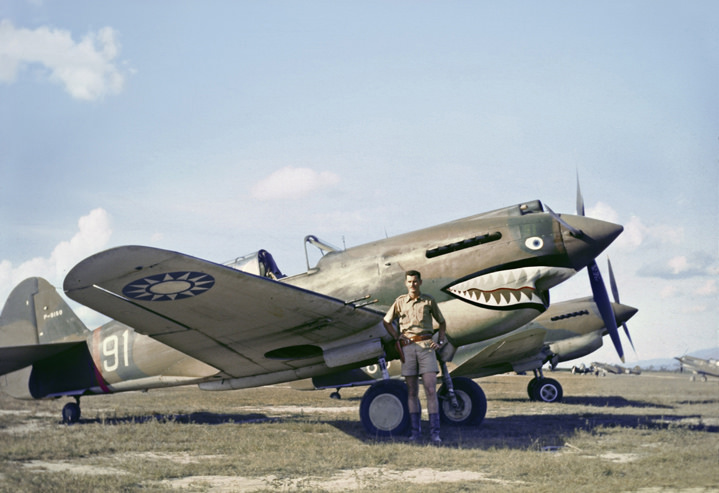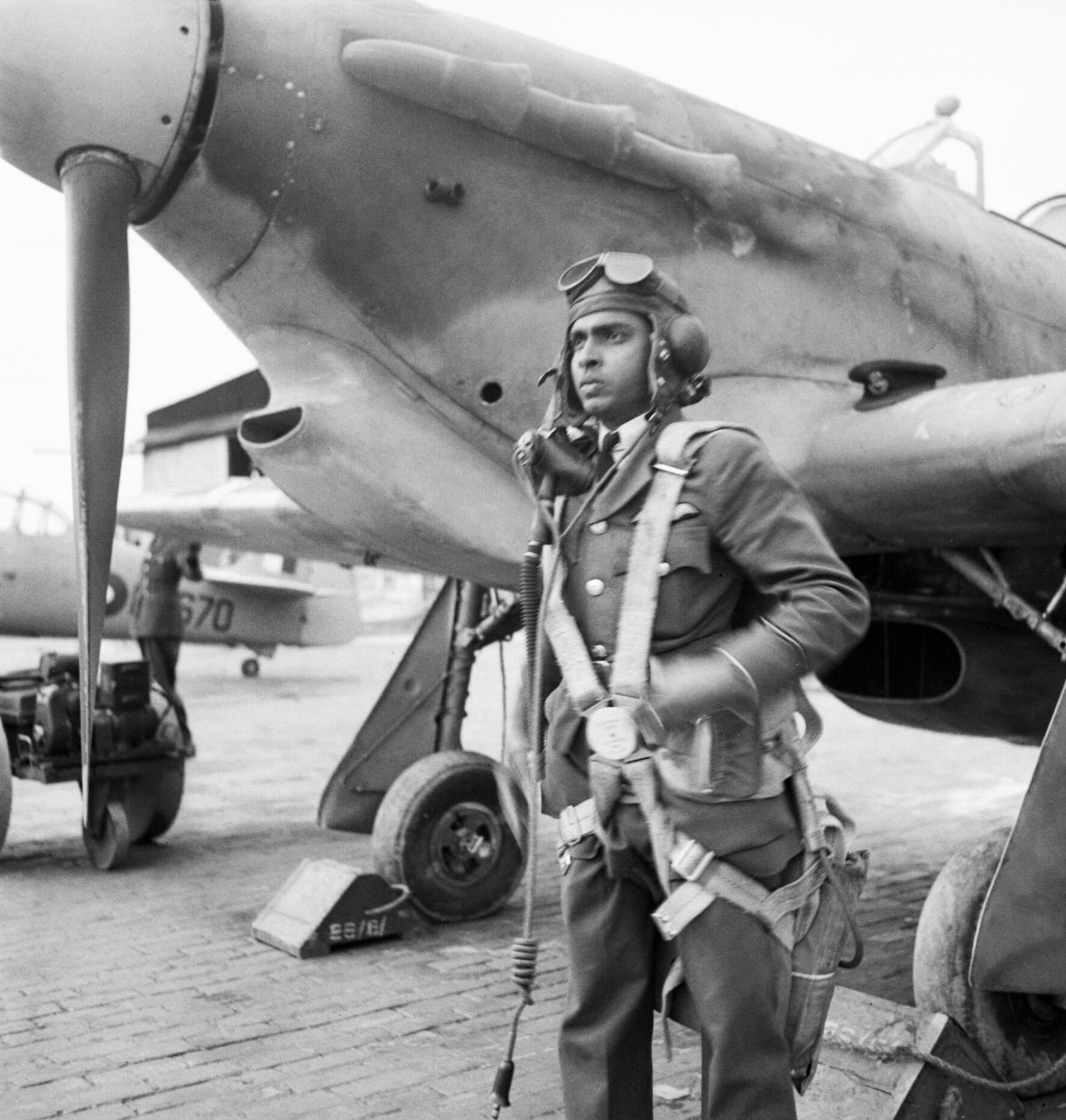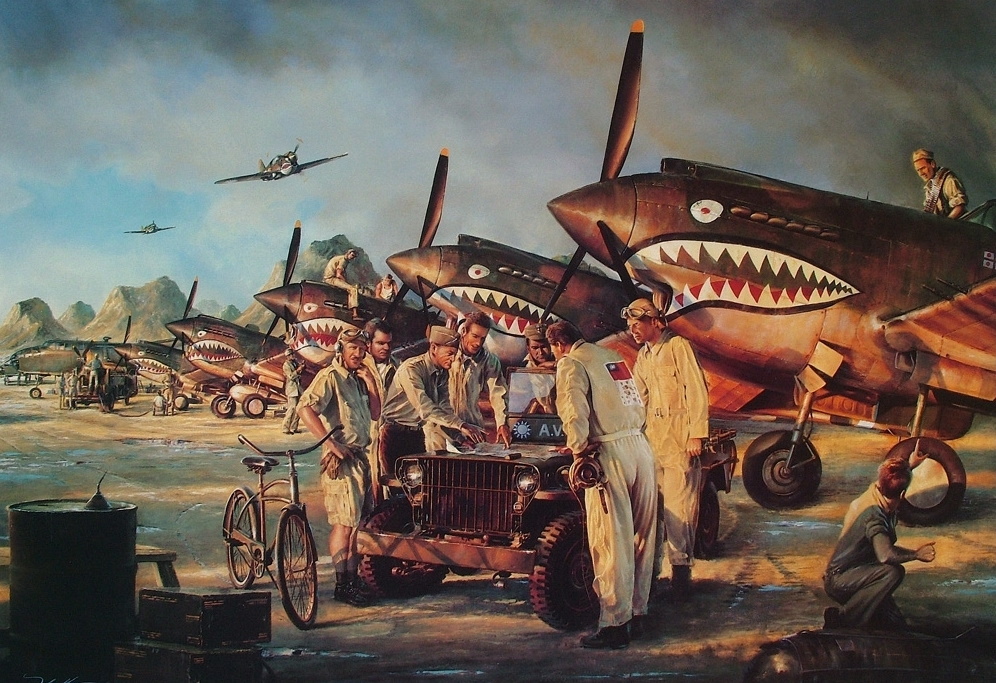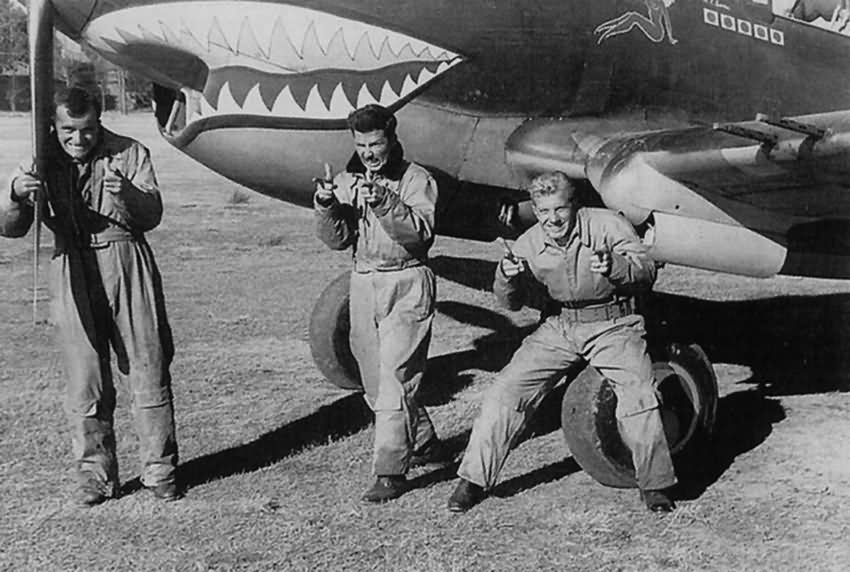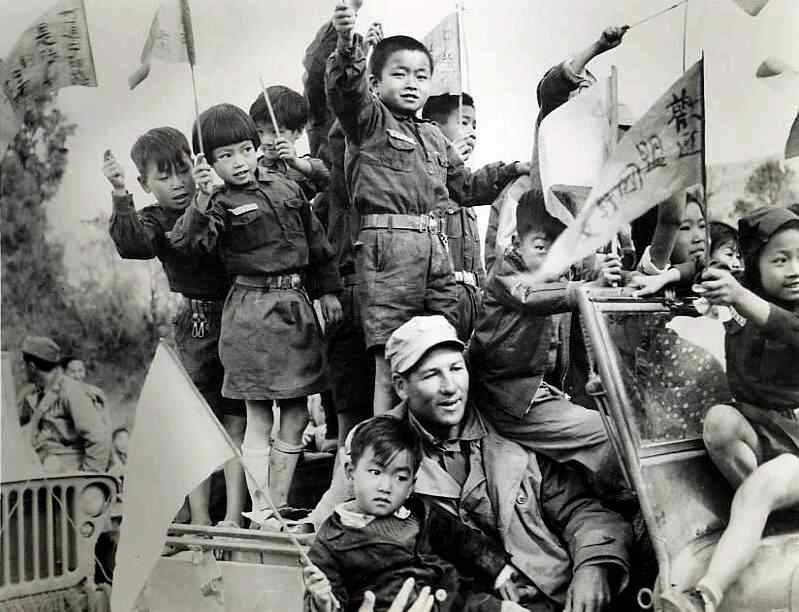AVG – AMERICAN VOLUNTEERS GROUP
 The American Volunteer Group provided the first organized air resistance the Japanese had faced since the beginning of the Sino-Japanese War in 1937. Beginning operations on December 21, 1941, the AVG kept jabbing at the Japanese whenever and wherever they could. The combined effort of the AVG and the British RAF kept the important Port of Rangoon open for almost three months after the first enemy assaults began. During its six months of operation over Burma and China, the AVG destroyed 297 enemy aircraft in air combat, while losing 14 of their own P-40s.
The American Volunteer Group provided the first organized air resistance the Japanese had faced since the beginning of the Sino-Japanese War in 1937. Beginning operations on December 21, 1941, the AVG kept jabbing at the Japanese whenever and wherever they could. The combined effort of the AVG and the British RAF kept the important Port of Rangoon open for almost three months after the first enemy assaults began. During its six months of operation over Burma and China, the AVG destroyed 297 enemy aircraft in air combat, while losing 14 of their own P-40s.
The air supply route over the Hump (Himalayas) was successfully defended, as well as the supply base depots in Kunming. Air operations by the 10-USAAF were officially inaugurated on April 2/3, 1942, in an attack by B-17s on shipping at Port Blair, Andaman Islands in the Bay of Bengal. This and similar operations entailed the use of an advanced base near Calcutta, a distance of 1200 air miles (1900 KM) from the home base at Karachi. Subsequent operations were characterized by the same difficulties of distance and the shortage of aircraft as well as unfavorable weather conditions. Consequently, these early missions were little more than harassing missions. During this same period, the India-China Ferry conducted operations transporting supplies from India to Burma and China. Service facilities, supply, and maintenance installations were also in the process of being built. Operations, in the main, were still of a defensive nature due to the inadequacy of equipment, personnel, and supplies, coupled with Japanese capabilities, which indicated still further advances in the China-Burma-India Theater.
Improvement of the Allied situation in the Indian Ocean permitted the movement of airbases eastward. Late in June, the 23d Fighter Group and elements of the 11th Bombardment Squadron were assembling in China. This regrouping was partially in anticipation of replacing the AVG whose contracts would expire on July 4, 1942, but mainly to provide increased air support for British and Chinese forces operating in China. The China Air Task Force became operational on July 4, 1942. In order to bring important enemy targets in southern China within bomber and fighter range, operations were conducted from a string of bases running in a northeast-southwest line starting from Henyang, followed by Lingling, Kweilin, Liuchow, and Nanning. To guard the ferry over the Hump, aircraft operated from Yunnanyi, in western China, and Dinjan in Assam. Bomber strikes included attacks on important Japanese airfields at Nanchang, southeast of Hankow, and Tien Ho airdrome, at Canton, in an effort to reduce Japanese numerical superiority. Fighter aircraft challenged every Japanese bomber raid over Free China, accounting for a number of enemy aircraft during every engagement.
During their eight months of operation, from July 4, 1942, to March 10, 1943, the claims of Hqs China Air Task Force included 182 enemy aircraft destroyed, and 87 probably destroyed. During the operations, 350 tons of bombs were dropped on Japanese installations and 50.000 tons of enemy shipping sunk. During the same period, 24 American aircraft were lost to enemy action.
The India Air Task Force organized in October 1942, had very little available combat power during its organization period. To add to their difficulties, the equipment required for an adequate early warning system was not available. Late in October, word was received that the 10-USAAF was to be relieved of the responsibility of operating the Ferry, effective December 1. Before any of the forces could be deployed, the Japanese attacked Dinjan on October 25. Approximately 100 planes bombed and strafed the field at Dinjan, as well as the newer fields at Chabua, Mohanbari, and Sookerating. Due to the inadequacy of the early warning system, the Americans suffered heavy losses. Five transport aircraft, five P-40s, and two P-43s were destroyed, while four cargo planes and 13 fighters were badly damaged. On the next day and on the 28, however, when the enemy came over again, the India Air Task Force squadrons were able to destroy fifteen Japanese raiders with little damage to themselves. For several weeks while the India Task Force was being built up, Gen Haynes employed his forces defensively with only occasional offensive missions by small flights of heavy bombers.
The opening attack of this campaign occurred on November 20, when eight B-24s carrying 40.000 pounds of bombs attacked the marshaling yards at Mandalay. From Myitkyina in northern Burma to Bangkok in Thailand, and Port Blair in the Andaman Islands, the India Task Force strafed at a low level and bombed from high altitudes. In 17 heavy bombing raids between November 20 and December 31, they dropped 414.000 pounds of high explosives on enemy targets. From April to December 1942, heavy bombers flew only 179 sorties and dropped 299 tons of bombs. Medium bombers from July to December flew 331 sorties and dropped 346 tons of bombs. Fighters from July to December 1942 flew 791 sorties and dropped 24 tons of bombs. The total tonnage dropped was 669 tons. During 1943 the India Air Task Force concentrated on the active defense of the Ferry Route between India and China, the airfields and equipment in the Assam area. During 1943, bomb totals of the India Air Task Force had been stepped up to an unusual degree. In January, the total of bombs dropped was about 200 tons; by May, it reached 400 tons. From November 1942 through September 1943, heavy and medium bombers performed 714 missions, flew 4.792 sorties, dropped 6.158 tons of bombs, and destroyed 44 enemy planes, with 39 probable destructions. In all, the India Task Force lost only 12 planes.
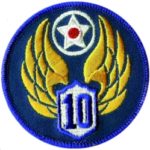 By Nov 1943, the 10-USAAF was making headway in gaining limited air superiority over Burma. That November, the 10-AAF joined Gen Stratemeyer’s Eastern Air Command, which in turn, was a part of the Southeast Asia Command under Lord Louis Mountbatten. Heavy bomber sorties for the year 1943 mounted to 2.751, with 4.651 tons of bombs dropped. Light bombers flew 4.003 sorties and dropped 4.243 tons of bombs. Local superiority, gained in the latter part of 1943, was maintained in 1944. During January and February, counter-air force operations were mainly defensive in nature. This was primarily due to the fact that the newly activated Eastern Air Command was in the process of planning its operations.
By Nov 1943, the 10-USAAF was making headway in gaining limited air superiority over Burma. That November, the 10-AAF joined Gen Stratemeyer’s Eastern Air Command, which in turn, was a part of the Southeast Asia Command under Lord Louis Mountbatten. Heavy bomber sorties for the year 1943 mounted to 2.751, with 4.651 tons of bombs dropped. Light bombers flew 4.003 sorties and dropped 4.243 tons of bombs. Local superiority, gained in the latter part of 1943, was maintained in 1944. During January and February, counter-air force operations were mainly defensive in nature. This was primarily due to the fact that the newly activated Eastern Air Command was in the process of planning its operations.
In February 1944, in attempting to attain local air superiority in support over the battle area of his Arakan Offensive, the enemy expended a major effort against the Allied air forces. However, the newly acquired Spitfires of one group took such a heavy toll that he was forced to abandon the effort. Verified Allied claims for January and February were 40 enemy aircraft destroyed, 19 probably destroyed, and 102 damaged. During the March, April, and May offensives, fighter action by Army Air Force units over Japanese bases, substantially broke the Japanese dominance of the air over Burma, destroying 224 aircraft, probably destroying 29 and damaging 58. The combined AAF and RAF score during March, April, and May was 309 enemy aircraft destroyed, 56 probably destroyed, and 193 damaged. In June 1944, a marked change in operational policies by the Japanese was evidenced. The enemy seemed to have turned to a form of hit-and-run guerrilla warfare. As a result, the number of enemy aircraft destroyed by the Allied Air Force, in the last half of 1944 never reached the totals amassed during the period March, April, and May.
The enemy did, however, conduct nuisance raids during this period and continued to send out photos and visual reconnaissance missions. The latter very seldom were permitted to return to their bases. This lack of air reconnaissance intelligence eventually led to complete Japanese disorganization and utter ignorance of the penetration movement which captured Meiktila. By the end of 1944, as a result, air superiority in Burma had been supplanted by air supremacy.
AIR OPERATIONS – INDIA-BURMA – 1945
It was obvious that the main Japanese air strength had been withdrawn to Siam. On March 15, 40 P-51s of the American Second Commando Group, flew a 1600 mile (2500 KM) round trip from the Cox’s Bazaar and attacked the Don Mouang Airfield, 12 miles north of Bangkok. They achieved complete surprise and destroyed 26 enemy aircraft, probably destroying 6 and damaging 51, for a loss of one P-51. Allied bombers continued to bomb Rangoon and the Don Mouang area with little or no opposition.
 By the last days of April 1945, there were only 12 enemy aircraft fighters in Burma and they were based in the Moulmein area. These, plus a few that could be brought in from Siam, occasionally showed themselves over the fighting front but were ineffective as a defensive or offensive force. The Eastern Air Command, which included the 10-USAAF for a period, destroyed or damaged 1114 enemy aircraft between December 15, 1943, and June 1, 1945, in India-Burma.
By the last days of April 1945, there were only 12 enemy aircraft fighters in Burma and they were based in the Moulmein area. These, plus a few that could be brought in from Siam, occasionally showed themselves over the fighting front but were ineffective as a defensive or offensive force. The Eastern Air Command, which included the 10-USAAF for a period, destroyed or damaged 1114 enemy aircraft between December 15, 1943, and June 1, 1945, in India-Burma.
10-USAAF OPERATIONS IN CHINA
In addition to operating with its major forces in the India-Burma area as discussed in the preceding paragraphs, the 10-USAAF was responsible for certain operations in China. Air Operations on the Salween River; during the period September 1944 to January 1945, the 10-USAAF fighter-bombers, flew approximately 1800 sorties from Burma bases against Japanese positions on the Salween front. China Offensive; in April, Hqs 10-USAAF was ordered to China. The advanced detachment was located in Luliang when a change of decision was made on May 2, 1945, removing the 10-USAAF from China and standing it down from combat operations at Piardoba, India. In the last week of June, the decision was changed and the 10-USAAF was again ordered to China, closing at Piardoba and opening at Kunming on July 26, 1945.
The basic conception of the reorganization in China, established the 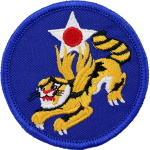 The Fourteenth Air Force (14-AAF) as the strategic air force to operate generally north of the twenty-seventh parallel on Japanese lines of communications and strategic targets, and the Tenth Air Force as the tactical air force to cooperate with the Chinese ground armies operating south of the twenty-seventh parallel.
The Fourteenth Air Force (14-AAF) as the strategic air force to operate generally north of the twenty-seventh parallel on Japanese lines of communications and strategic targets, and the Tenth Air Force as the tactical air force to cooperate with the Chinese ground armies operating south of the twenty-seventh parallel.
POSTWAR OCCUPATION – EVACUATION – SUPPLY
With the end of the war, the 10-USAAF was selected by the commanding general of the Army Air Forces, China Theater, as the operating agency for all intra-China air transportation. Hqs 10-USAAF moved back to Kunming on August 25, 1945. A partial indication of air power’s contribution to the victorious results attained in the China-Burma-India Theater is provided in a tabulation of statistical data based on claims submitted by the operating air forces. In spite of their impressiveness, the listed data does not present the overall objectives gained as a result of the victories indicated. The following presentation covers these objectives.
AIR POWER IN INDIA-BURMA
Airpower not only played a major role in preventing the Japanese occupation of India but completely isolated the Burma Battlefields. This action proved demoralizing to the enemy and had an adverse effect on his war-making capability. The air transport operations on which survival of the ground depended, and the forces operating on the ground, were rendered free from air attack by the enemy with the attainment of air superiority in the India-Burma area. By direct attack on enemy troops, installations, equipment, and lines of communication, airpower aided in the destruction of the Japanese forces in Burma. From India-Burma, airpower supplied the military effort in China with the greatest air transport effort of its time.
AIR POWER IN CHINA
Airpower was instrumental in preventing the occupation and control of all of China by the Japanese armies. Strikes on shipping and interdiction of north China‘s railways and highways, and very heavy bombardment attacks on Japanese home islands by China-based aircraft, materially assisted in the disruption of the entire Japanese war economy and war-making potential. Operations of China-based air power forced the Japanese to dissipate logistical potential to campaigns in China, which otherwise might have been more effectively employed in the Pacific. By attaining air superiority, China-based air power assured the allied forces and operations protection from enemy air attacks. China-based air power contributed heavily to the attrition of Japanese military power.
CONCLUSIONS
Air operations in the China-Burma-India Theater have given rise to the formulation of a new doctrine and provided strategic planners with a wider range of thought in determining operations for the future. Prior to 1942, air transport was confined in the main, to carrying passengers, limited supplies, usually of an emergency nature, mail, and aid for cargo transport on a limited scale. The situation in China demanded that some form of aerial transport be initiated since the terrain and the enemy prevented the use of the conventional land and sea lanes of communication. Initial successes soon proved that only the number of available aircraft and airfields limited the amount of cargo that could be airlifted. As these planes were supplied, new airfields were constructed and personnel made available, and the intensity of the ground and air operations increased. The ability of air transport to adequately provide for combat forces isolated from the land and sea lanes of communication was amply demonstrated. The acceptance of this new doctrine, new because it was not accepted by strategic planners prior to 1942, gives rise to three ideas:
(1) Land or sea lines of communication to battle areas are not essential, though the size of force supported will be governed by limitations discussed previously.
(2) The aerial line of communication is particularly adaptable to operations in areas where: (a) difficult terrain forms a barrier to landlines; (b) sea lines or waterways are not available or enemy-controlled; b>(c) a combination aforementioned conditions; (d) the use of an aerial line of communication may be required where speed rather than the economy is the governing factor.
(3) Force may be massed, supplied, and sustained anywhere in the world.
(4) Air transport will provide flexibility in the defense of an extensive area, where the resources of a nation preclude the establishment of a defense of the entire area, and the exact location of the enemy strike is unknown.
Edward M. Hudak
Maj, Field Artillery
